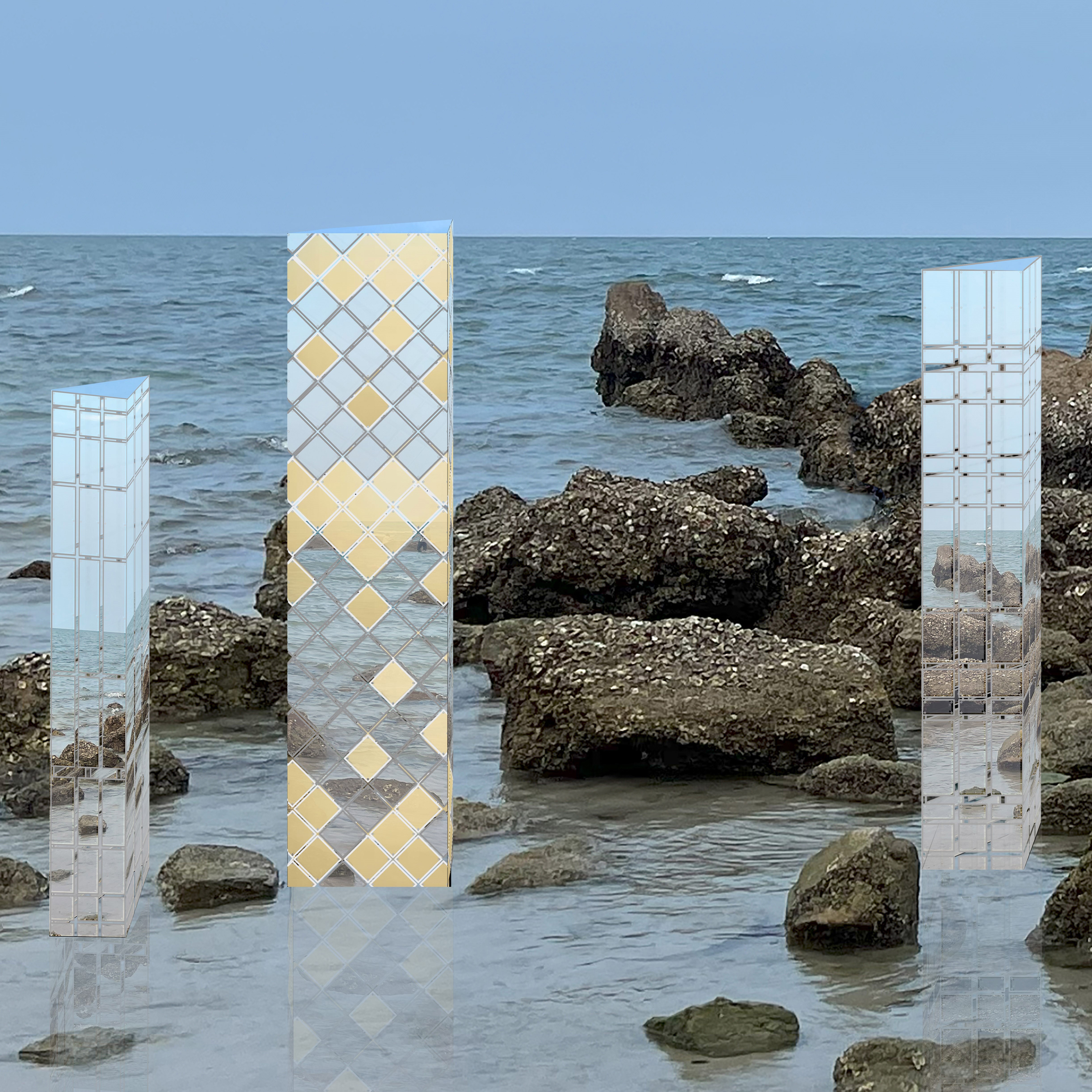Changes in Aesthetic Natural Phenomena through Site Specific Art, on Hua Hin Beach
DOI:
https://doi.org/10.69598/sbjfa263675Keywords:
Site-specific Art , Aesthetics, Natural PhenomenaAbstract
The article delves into a study that thoroughly examines the shifts in the aesthetic phenomenon of Hua Hin Beach through site-specific art, in which the researcher used Hua Hin Beach as a case study. Hua Hin is an old resort town that has been very popular from the past to the present. Some beaches are unique both physically and aesthetically. The wide sandy beach is white and delicate, with clear seawater; the main highlight is the rocks lined up uniquely. The author was inspired to present a story from observing the experience value of beauty and natural phenomena. The objective is as follows: 1) The author aims to question and interpret the site-specific art interaction with the natural environment and how it can create new perspectives for visitors to the beach; 2) It serves as a conduit for the transformation of all things; 3) To show the impermanence of existence in the natural environment; 4) To explore the delicate relationship between man and the environment, and to collect data through study, research, observation of beach visitor, interviewers, and an analytical study of the artistic elements of local site-specific art such as textures, colours, shapes, and dimensions of reflections in the natural environment. In conclusion, the study and design of this artwork are part of presenting a different perspective; for example, the correlation between visual depictions and their underlying implications plays an integral role in grasping the interconnection among works of art, the changes in nature, and the changes in people.
Downloads
References
ชุติมา โสดามรรค. (2563). การจำแนกประเภทศิลปะจัดวางในไทยโดยทฤษฎีของมาร์ค โรเซนทอล. วารสารศิลปกรรมศาสตร์ มหาวิทยาลัยขอนแก่น, 13(1), 148-152. https://so02.tci-thaijo.org/index.php/fakku/article/view/240673/168640
ภาณุ บุญพิพัฒนาพงศ์. (2561ก, 6 มีนาคม). Land art ศิลปะบนผืนโลกความไม่จีรังยั่งยืนในสภาพแวดล้อมทางธรรมชาติ. เดอะ โมเมนตัม. https://themomentum.co/land-art/
________ . (2561ข, 6 กุมภาพันธ์). Conceptual Art ศิลปะแห่งความคิดที่ละทิ้งความงามและต่อต้านความสูงส่ง. เดอะ โมเมนตัม. https://themomentum.co/conceptual-art/
________ . (2561ค, 23 มกราคม). มินิมอลลิสต์: ศิลปะแห่งการลดทอยและความจริงแท้ของวัตถุ. เดอะ โมเมนตัม. https://themomentum.co/minimalism-art/
ปริชาติ วงค์เจริญ. (ม.ป.ป.). แบบฝึกหัดทักษะวิชาทัศนศิลป์ เรื่อง สร้างสรรค์งานทัศนศิลป์ ชั้นมัธยมศึกษาปีที่ 2 เล่มที่ 1 ความรู้เกี่ยวกับทัศนธาตุและพื้นฐานการรับรู้. ครูบ้านนอก.คอม. https://www.kroobannok.com/news_file/p31598210954.pdf
ปอ เปรมสำราญ. (2561, 14 กุมภาพันธ์). วิถีแห่ง ‘วะบิ-ซะบิ’ ความงามที่มีรอยตำหนิและกาลเวลาเป็นกัลยาณมิตร. เดอะ โมเมนตัม. https://themomentum.co/wabi-sabi/
ศรายุทธ ศรีทิพย์อาสน์. (ม.ป.ป.). ออกแบบบ้านให้รู้สึกโปร่งสบาย ด้วยหลักวิทยาศาสตร์. บ้านและสวน. https://www.baanlaesuan.com/241229/ideas/house-ideas/ceiling-hight
หทัยชนก ช่วงไธสง. (2533). วิถีชีวิตชาวประมงในยุคสมัยแห่งการเปลี่ยนแปลง ศึกษาเฉพาะกรณีแนวโน้มการย้ายท่าเรือประมงและหมู่บ้านชาวประมง ตำบลหัวหิน อำเภอหัวหิน จังหวัดประจวบคีรีขันธ์ [สารนิพนธ์ศิลปศาสตรบัณฑิต ไม่ได้ตีพิมพ์]. ภาควิชามานุษยวิทยา คณะโบราณคดี มหาวิทยาลัยศิลปากร.
ArtCentrica. (2021, November 26). The Mirror and Its Symbolic Meaning in Art History. https://www.artcentrica.com/2021/11/26/the-mirror/
Boonpipattanapong, P. (2018a, March 6). Land Art Ephemerality in the Natural Environment. The Momentum. https://themomentum.co/land-art/. [in Thai].
________ . (2018b, 6 February). Conceptual Art the Art of Ideas that Forsakes Beauty and Opposes Nobility. The Momentum. https://themomentum.co/conceptual-art/ [in Thai].
________ . (2018c, 23 January). Minimalism the Art of Minimization and Authenticity of Object. The Momentum. https://themomentum.co/minimalism-art/ [in Thai].
Chaungtaisong, H. (1990). The Impact of Social/Environmental Changes on the Fisherman’s Living Cycle [Unpublished Bachelor’s Thesis]. Anthropology Department, Faculty of Archeology, Silpakorn University. [in Thai]
Eliasson, O. (2008). Tilted Circles Diagram [Online image]. Studio Olafur Eliasson. https://olafureliasson.net/artwork/tilted-circles-diagram-2008/
________. (2014). Riverbed [Online image]. Studio Olafur Eliasson. https://olafureliasson.net/artwork/riverbed-2014/
Holt, N. (1973-76). Sun Tunnels [Online image]. Holt/Smithson Foundation. https://holtsmithsonfoundation.org/sun-tunnels
Kosuth, J. (1965). One and Three Chairs [Online image]. MoMA. https://www.moma.org/collection/works/81435
Kwade, A. (2022). In Blur [Online image]. Desert X. https://desertx.org/dx/desert-x-alula-2022/alicja-kwade
Lapierre, A. (2011). Ring Mirror Installation by Arnaud Lapierre @Place Vendôme, Paris [Online image]. Yatzer. https://www.yatzer.com/Ring-by-Arnaud-Lapierre
Morris, R. (1965). Untitled [Online image]. Tate. https://www.tate.org.uk/art/artworks/morris-untitled-t01532
Picasso, P. (1910). Girl with a Mandolin [Online image]. MoMA. https://www.moma.org/collection/works/80430
Premsamarn, P. (2018, February 14). Way of Wabi-Sabi a Beauty with Flaws and Time. The Momentum. https://themomentum.co/wabi-sabi/ [in Thai].
Sodamak, C. (2020). A Theory of the Classifications of Thailand’s. Journal of Fine and Applied Arts, Khon Kaen University, 13(1), 141-157. https://so02.tci-thaijo.org/index.php/fakku/article/view/240673/168640 [in Thai]
Srithipart, S. (n.d.). Design the house to feel airy with science principles. Baanlaesuan. https://www.baanlaesuan.com/241229/ideas/house-ideas/ceiling-hight. [in Thai].
Wallentine, A. (2022, January 14). Reflections on the mirror in art. Art UK. https://artuk.org/discover/stories/reflections-on-the-mirror-in-art
Wongchareon, P. (n.d.). Visual Art Exercises: Creative Art Works, Secondary School M 2, Vol.1 Art Element and Perception Theory. Kroobannok.com https://www.kroobannok.com/news_file/p31598210954.pdf [in Thai].

Downloads
Published
How to Cite
Issue
Section
License
Copyright (c) 2023 © by the Author(s) & Silpa Bhirasri Journal of Fine Arts.

This work is licensed under a Creative Commons Attribution-NonCommercial-NoDerivatives 4.0 International License.
The journal's editorial team does not have to agree with the views and comments in the author's article, nor are they responsible for the comments.











